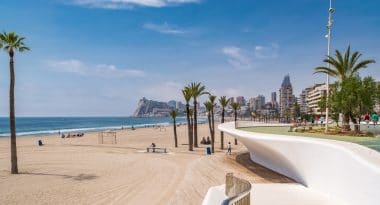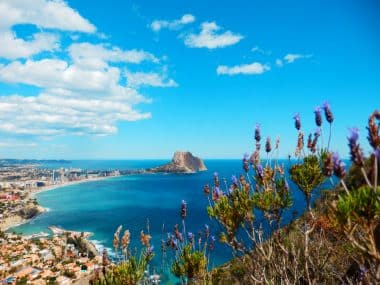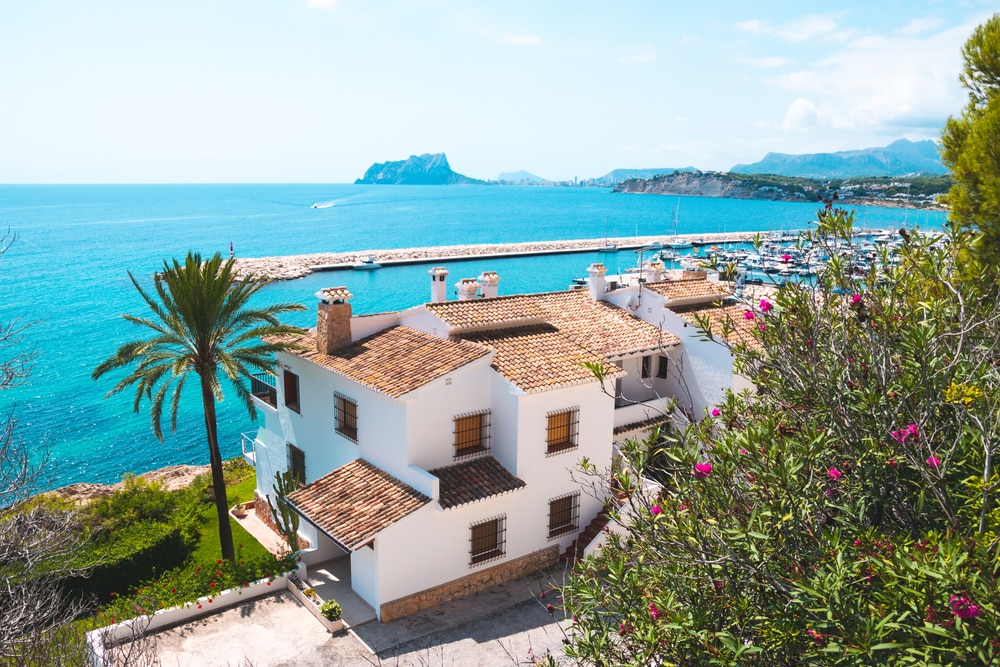The mild Mediterranean climate is considered a great advantage of the Levant in Spain’s southeast. While winter is hesitantly saying goodbye in northern Europe, the sweet and heavy scents of lemon and orange blossom are already settling over the Mediterranean coastal region. Numerous holidaymakers enjoy the beautiful beaches and the tranquil holiday resorts there on the Costa Blanca. Mountains in the hinterland and the charming, historic city of Alicante sometimes offer a change from the sunlit beach life.
Costa Blanca: the white coast off Alicante

Between Cabo de la Nao and Cabo de Palos near Cartagena, the Costa Blanca stretches over about 160 kilometers. Because it is assigned to the province of Alicante, the small town of Dénia is also included.
The region’s holidaymakers enjoy the great holiday fun on the flat sandy beaches as well as the beach sections with picturesque cliffs. In addition to friendly resorts such as Xàbia and Dénia, the Mecca of sun worshippers Benidorm can also be found here.
From Dénia to Benidorm
There are a good 50 kilometres between the two towns, and there are attractive beaches off Dénia with the fine sandy Playa les Marines and the cliff coast Playa Les Rotes. In addition, the small town has a beautiful harbor and a historic center with winding alleys below an old fortress.
In the vicinity of Dénia, as in neighboring Xàbia, there are beautiful retirement homes of quite wealthy Europeans next to small, Mediterranean holiday apartments. Xàbia’s Cap Sant Antoni offers enchanting views, and there are also picturesque bays between towering cliffs and the historic town centre surrounded by mighty walls at the foot of the Sierra de Montegó. Even the Gothic Iglesia de San Bartolomé presents itself defensively and powerfully.
Miles of beaches, marinas, many restaurants, hotels and discos make the resorts of Calpe and Altea hotspots of beach tourism. Off the coast lies the 332-metre-high rock monolith Penyal d’Ifach, the much-photographed landmark of the Costa Blanca. Further south is the neatly spruced up town of Altea, which has developed into an artists’ colony, as the brisk sale of art, but also of knick-knacks in the old town alleys suggests.
Benidorm: Total holidays in the Manhattan of the Costa Blanca
Benidorm has long been considered a centre of tourism on the Costa Blanca. Modern buildings line the two beautiful sandy beaches Playa de Levante and Playa de Poniente, with the Balcón del Mediterráneo viewing platform in between. The daily beach life is complemented by a famous nightlife in bars, discos and trendy clubs. In Benidorm there is also the Terra Mítica amusement park with countless rides, the Aqualand park and the Aquascope, a submarine that can be used to make various excursions from the port.
20 kilometres away from Benidorm, a picturesque castle ruin and the free-standing bell tower of Guadalest crown extremely bizarre rock formations. The mountain village can only be reached through a tunnel driven into the rock, then all visitors rave about the phenomenal view.
Alicante and Elche: especially light and palm trees over palm trees

Even the ancient Greeks and the Romans once called Alicante Lucentum because of the special light and the Moors Al-Lucant. The well-kept city derives its special charm from the special Mediterranean atmosphere. Her big heart beats on the palm-fringed Explanada de Espãna, which runs parallel to the harbour. There, the Alicantinos and their guests stroll over a floor mosaic with a beautiful wave pattern, people meet for coffee or Sunday concerts. In the north of Alicante is the clean city beach Playa del Postiguet, from where an elevator leads to the Castillo de Santa Bárbara at a height of almost 170 meters. Below, the old town invites you to stroll: the Renaissance cathedral of San Nicolás de Bari and the Museo de Arte Contemporáneo La Aseguranda with exquisite art exhibitions in the oldest patrician house in the city are worth seeing.
Tall and slender date palms also dot the parks and gardens of Elche – and Europe’s largest palm grove, El Palmeral de Europa, is a legacy of ancient Moorish culture here. Particularly beautiful specimens can be found in the Huerto del Cura. A sought-after photo object on the spot is the eight-armed Palma Imperial, which is over 2 centuries old.
Elche is also known as the site of the Dama de Elche, a stone bust of a woman from the Iberian period, which is now on display in the Museo Argueológico Nacional in Madrid . Another relic from ancient times is the mystery play Misteri d’Elx. It is a UNESCO World Heritage Site. The religious drama, which dates back to the 13th century, is performed every year in August and is set in the admirable 17th-century church of Santa Maria.
Können wir Ihnen helfen?
Benötigen Sie Unterstützung bei Ihrer Reiseplanung oder weitergehende Informationen zu einzelnen Reisezielen? Wir freuen uns über Ihre Kontaktaufnahme.


